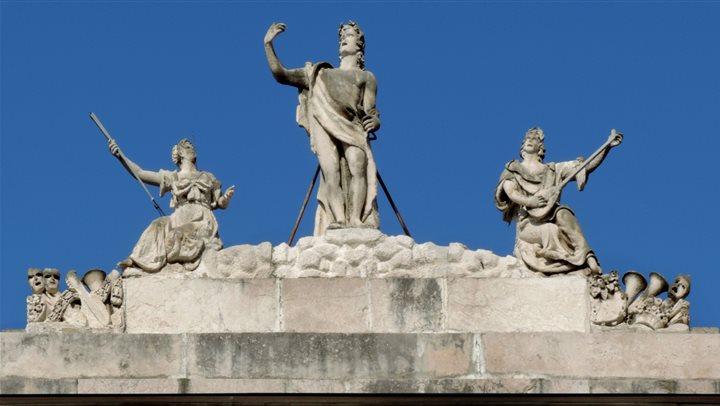Verdi Theatre
Realised between 1798 and 1801 on behalf of the stockbroker Giovanni Tommasini, the theatre – called “New”, renamed “Great” in 1821, “Municipal” in 1861 and finally “Verdi” in 1901, the year of the composer’s death, contributed to shape the new urban plan in a zone of connection between Piazza della Borsa and what would become Piazza Unità.
The original project by Venetian architect Giannantonio Selva (author of “La Fenice” theatre) was criticised by the Director of the Civic Factories of Trieste Carlo Steinlein, who asked architect Matteo Pertsch (engaged in the construction of the Carciotti Building) to make the variations required, especially to the main façade.
The difficulty of composing the different ideas of Steinlein and of the two architects produced significant delays in the works, and an unclear distinction of the respective contributions, but what appears clear is Pertsch's inspiration in the neoclassical model of his master, Giuseppe Piermarini, the designer of the Teatro alla Scala in Milan.
The sculptures on the main façade (Apollo among the muses of Tragedy and Lyric) as well as those of the niches of the basement (Pluto and Mars) were attributed to Antonio Bosa, Canova's student. On the same façade are also five cannon balls, to remember the bombing by the French navy experienced by the city in 1813.
Inside, the main hall with a capacity of 1300 seats and a foyer, originally “ballroom”, that develops over two levels with a majestic peristasis of ionic columns upon which the loggia lies.
The most important restorations have been realised in 1882/4 (by Eugenio Geiringer who modified the façade in front of the sea and the foyer) and in 1992/7, with the restoration of the original structure of the theatre hall and the covering on the side facing the sea.
Giuseppe Verdi had a strong bond with this theatre, for which after the extraordinary success of audience of the Nabucco in 1844 he composed two pieces, “Il corsaro” (“The corsair”) and “Stiffelio” (1850), whose execution he personally directed, entrusting its interpretation to his wife Giuseppina Strepponi.
Among the most famous conductors and singers who gave glory to the theatre there are respectively Mahler, Strauss, Toscanini, Karajan, De Sabata and Callas, Corelli, Christoff, Nicolai.











